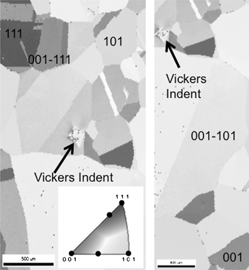Crossref Citations
This article has been cited by the following publications. This list is generated based on data provided by
Crossref.
Caër, C.
Patoor, E.
Berbenni, S.
and
Lecomte, J.-S.
2013.
Stress induced pop-in and pop-out nanoindentation events in CuAlBe shape memory alloys.
Materials Science and Engineering: A,
Vol. 587,
Issue. ,
p.
304.
Lee, Seok-Woo
Meza, Lucas
and
Greer, Julia R.
2013.
Cryogenic nanoindentation size effect in [0 0 1]-oriented face-centered cubic and body-centered cubic single crystals.
Applied Physics Letters,
Vol. 103,
Issue. 10,
Lawrence, Samantha K.
Zbib, Hussein M.
Cordill, Megan J.
Wurster, Stefan
and
Bahr, David F.
2014.
Statistical Quantification of the Impact of Surface Preparation on Yield Point Phenomena in Nickel.
Metallurgical and Materials Transactions A,
Vol. 45,
Issue. 10,
p.
4307.
Abdolrahim, Niaz
Zbib, Hussein M.
and
Bahr, David F.
2014.
Multiscale modeling and simulation of deformation in nanoscale metallic multilayer systems.
International Journal of Plasticity,
Vol. 52,
Issue. ,
p.
33.
Shao, Shuai
Abdolrahim, Niaz
Bahr, David F.
Lin, Guang
and
Zbib, Hussein M.
2014.
Stochastic effects in plasticity in small volumes.
International Journal of Plasticity,
Vol. 52,
Issue. ,
p.
117.
Maughan, Michael R.
and
Bahr, David F.
2015.
Dislocation Activity Under Nanoscale Contacts Prior to Discontinuous Yield.
Materials Research Letters,
Vol. 3,
Issue. 1,
p.
58.
Askari, Hesam
Maughan, Michael R.
Abdolrahim, Niaz
Sagapuram, Dinakar
Bahr, David F.
and
Zbib, Hussein M.
2015.
A stochastic crystal plasticity framework for deformation of micro-scale polycrystalline materials.
International Journal of Plasticity,
Vol. 68,
Issue. ,
p.
21.
Maughan, Michael R.
and
Bahr, David F.
2016.
Discontinuous Yield Behaviors Under Various Pre-Strain Conditions in Metals with Different Crystal Structures.
Materials Research Letters,
Vol. 4,
Issue. 2,
p.
83.
Burch, Alexandra
Yeager, John
and
Bahr, David
2017.
Nanoindentation of HMX and Idoxuridine to Determine Mechanical Similarity.
Crystals,
Vol. 7,
Issue. 11,
p.
335.
Schuessler, B.J.
Wo, P.C.
and
Zbib, H.M.
2018.
The influence of grain boundaries and grain orientations on the stochastic responses to low load nanoindentation in Cu.
Materials Science and Engineering: A,
Vol. 715,
Issue. ,
p.
226.
Kucharski, Stanisław
and
Woźniacka, Stefania
2019.
Size Effect in Single Crystal Copper Examined with Spherical Indenters.
Metallurgical and Materials Transactions A,
Vol. 50,
Issue. 5,
p.
2139.
Ctvrtlik, Radim
Tomastik, Jan
Vaclavek, Lukas
Beake, Ben D.
Harris, Adrian J.
Martin, Alberto Sanchez
Hanak, Michal
and
Abrham, Petr
2019.
High-Resolution Acoustic Emission Monitoring in Nanomechanics.
JOM,
Vol. 71,
Issue. 10,
p.
3358.
Zhang, X.K.
Huang, J.C.
Lin, P.H.
Chuang, W.S.
Liu, T.Y.
Wu, Y.C.
Liao, Y.C.
and
Jang, Jason S.C.
2020.
Effect of orientation and loading rate on the incipient behavior of Ti60(AlCrVNb)40 medium entropy alloy.
Materials Science and Engineering: A,
Vol. 775,
Issue. ,
p.
138969.
Lin, P.H.
Huang, J.C.
Zhang, X.K.
Chou, H.S.
Chuang, W.S.
Liu, T.Y.
Liao, Y.C.
and
Jang, J.S.C.
2020.
Room- and elevated-temperature nano-scaled mechanical properties of low-density Ti-based medium entropy alloy.
Materials Science and Engineering: A,
Vol. 798,
Issue. ,
p.
140140.
Cao, Fu-Hua
Wang, Yun-Jiang
and
Dai, Lan-Hong
2020.
Novel atomic-scale mechanism of incipient plasticity in a chemically complex CrCoNi medium-entropy alloy associated with inhomogeneity in local chemical environment.
Acta Materialia,
Vol. 194,
Issue. ,
p.
283.
Liu, Siqi
Wan, Di
Guan, Shuai
Fu, Yuequn
Ren, Xiaobo
Zhang, Zhiliang
and
He, Jianying
2021.
Microstructure and nanomechanical behavior of an additively manufactured (CrCoNiFe)94Ti2Al4 high-entropy alloy.
Materials Science and Engineering: A,
Vol. 823,
Issue. ,
p.
141737.
Varillas, Javier
Očenášek, Jan
Torner, Jordi
and
Alcalá, Jorge
2021.
Understanding imprint formation, plastic instabilities and hardness evolutions in FCC, BCC and HCP metal surfaces.
Acta Materialia,
Vol. 217,
Issue. ,
p.
117122.
Zhao, Yakai
Park, Jeong-Min
Jang, Jae-il
and
Ramamurty, Upadrasta
2021.
Bimodality of incipient plastic strength in face-centered cubic high-entropy alloys.
Acta Materialia,
Vol. 202,
Issue. ,
p.
124.





